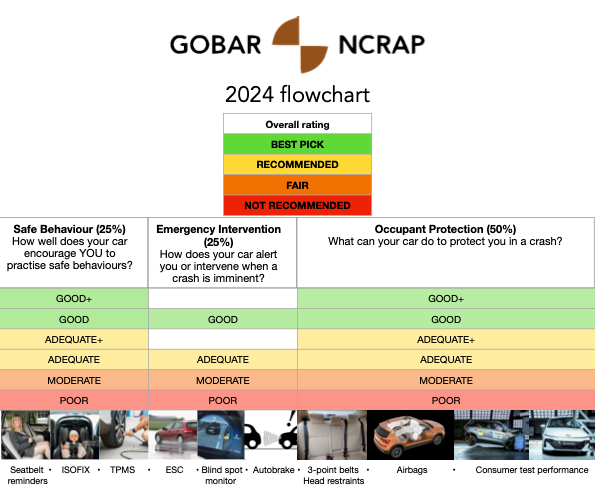Understanding the Index

What is it?
The safety equipment index is intended to help you compare the fitment of important safety features to different cars you're shopping for.
Finding a car
To find a new car, head over to the new car index and click on the image of a car.
-
Look for the variant type: a car may have a single evaluation for 'all variants' or two: one 'with standard equipment' and one 'with optional equipment'. The exact variant used for evaluation is displayed on each car's landing page.
-
Look for the date of evaluation: there is a chance that the car itself may have been updated since then. Also, look for the year of evaluation: the assessment criteria change every year.
-
Only compare cars of similar segments! Larger cars are inherently safer for occupants[see more] and more dangerous for pedestrians, motorcyclists and other vulnerable users of the road you share.
Reading the comparisons
Each car is evaluated on three categories of safety: Encouraging Safe Behaviour, Emergency Intervention and Occupant Protection, and then given an overall verdict based on a weighted score.

Since there are so many contributing factors, information is lost in the overall verdict.
-
The overall verdict is a convenient shorthand, but is often quite misleading; look at each category individually to find safety features more likely to be relevant to you.
Your responsibilities
Before expecting your car to keep your family safe, you need to ask yourself:
-
Will every adult in the car be wearing a seatbelt?
-
Airbags can cause neck and spinal cord injuries in unbelted occupants and certainly cannot substitute seatbelts.
-
Adult dummies in all legislative as well as consumer crash tests, like Global NCAP #SAFERCARSFORINDIA, are belted.
-
Someone not wearing their seatbelt can put other belted occupants in the car at up to 40% greater risk of serious injury or death — an unbelted occupant can become a projectile, injuring even belted occupants in a car with airbags and an intact passenger compartment.
-
That's why wearing seatbelts only in the front seat is simply not enough, as demonstrated in this explainer video from the US Insurance Institute for Highway Safety.
-
-
Are children under 12 seated in correctly installed, age-appropriate child restraints?
-
Consult the car's owner's manual for recommended child restraints for different age groups and acceptable installation positions.
-
Global NCAP #SAFERCARSFORINDIA dynamic crash testing results for child occupant protection take for granted that the restraints recommended by the vehicle manufacturer are being used.
-
Adult seatbelts on their own are not appropriate for children because of the height of the shoulder belt.
-
Unrestrained children may be ejected from the car.
-
-
Are you in full control of driving at all times?
-
ADAS technologies like AEB and lane support, increasingly common on Indian cars, are basic sensor-based emergency safety assist systems, NOT highway assist systems capable of assisted driving.
-
Some manufacturers 'bundle' comfort systems like Adaptive Cruise Control and lane keeping into a 'Highway Assist' system to improve driver comfort. These systems require varying levels of driver engagement and have different safeguards, but all require attention.
-
Some vehicle manufacturers and parts vendors market such systems using misleading terms like 'autonomous' or 'self-driving'.
-
And even then...
Vehicle safety is constantly evolving, and unfortunately there is no single analytical solution for it. The great progress being made by the vehicle safety community can't account for many types of crashes that cars are inherently incapable of avoiding or protecting in. That's why better drivers and better roads can't be ignored.
About the used car archive
The used car evaluations only compare the safety equipment fitted to models when they were sold as new, during the period reflected by the date stamp on the result. They can't guarantee that the performance of this equipment matches that during the car's initial purchase. Used car buyers are advised to inspect the crash history of the unit they intend to purchase and consult the vehicle manufacturer to learn about any pending recalls.



